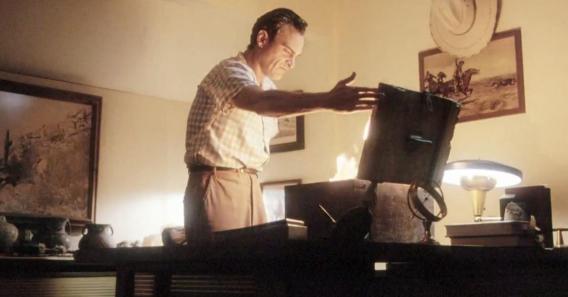Last week, Keith Phipps wrote a thoughtful, openly conflicted piece for the Atlantic about deleted scenes—passages from movies that a director has filmed, only to discard them from the final release. These often show up on DVDs, of course; the peg for Phipps’ piece is the DVD of The Master, which includes 20 minutes of scenes that Paul Thomas Anderson excised from the film, and which Anderson has edited together into something called “Back Beyond.” Phipps rightly says that the 20-minute quasi-short film “plays like a B-side to The Master.”
Much of what we see in “Back Beyond” is as enigmatic and elusive as the The Master itself. But we do get, as Phipps points out, some additional narrative information that was left out of Anderson’s final cut—particularly about the Master’s book The Split Saber. In “Back Beyond,” Lancaster Dodd’s son-in-law (Rami Malek) says the book was so powerful that it drove some who read it to kill themselves, and that this is why Dodd (Philip Seymour Hoffman) has hidden it. (This echoes claims made about an L. Ron Hubbard manuscript, The Dark Sword, Excalibur.)
Since this new information might affect one’s interpretation of The Master, Phipps asks, “Do deleted scenes count?” That is, when trying to make sense of a movie—a more challenging activity than usual with a movie as slippery as The Master—is it fair to bring these excised scenes to bear?
This, I think, is precisely the wrong question to ask about such scenes. If you find that they help illuminate what we actually see in the movie itself, then of course you can consider them—just as you can consider any number of other matters also external to the film: the director’s previous work, the public perception of the movie’s star, and so on. Phipps suggests that there’s a “peril” in watching deleted scenes, since, “once watched, they’re hard to forget and certain to cast a shadow over future viewings, however apocryphal their status.” The choice of apocryphal seems telling: It suggests that the work of art is a sacred thing, which, like the Bible, is liable to be wrongly interpreted if mixed with material that does not have the stamp of God.
But what is great about deleted scenes is that they remind us that a work of art is not a sacred, inviolable artifact that springs fully formed from the head of anyone. Art is the result of choices made by—in the case of movies—directors, actors, editors, even producers and studio executives. We might tend to think that those in the latter category are more likely to ruin a movie than improve upon it, but, as Phipps acknowledges, sometimes director’s cuts are worse than what makes it to theaters.
Paul Thomas Anderson seems happily aware of the messiness of movie-making: While he is probably as artistically ambitious as any prominent contemporary American director, he mischievously sprinkles his movie trailers—which, in contrast to the usual Hollywood practice, he produces himself—with scenes that he hasn’t used in the film’s final cut. Perhaps the most striking such scene from the trailers for The Master shows Freddie Quell (Joaquin Phoenix) opening a box and seeing whatever is inside burst into flame. Phipps notes the apparent allusion to Pandora, and sees a metaphor for deleted scenes (things “perhaps better left unexplored”). But there are other possible allusions as well—to the box in Kiss Me Deadly, for instance, which may have inspired Marcellus’s briefcase in Pulp Fiction and the finale of Raiders of the Lost Ark.
Did Anderson intend for us to think about those movies? If he didn’t, do those allusions count? I don’t think those are the right questions, either. If we can make some sense of the movie a director has made by thinking about what such allusions might mean, then they’re worth talking about. When it comes to the movies of Paul Thomas Anderson, they almost certainly will be.
